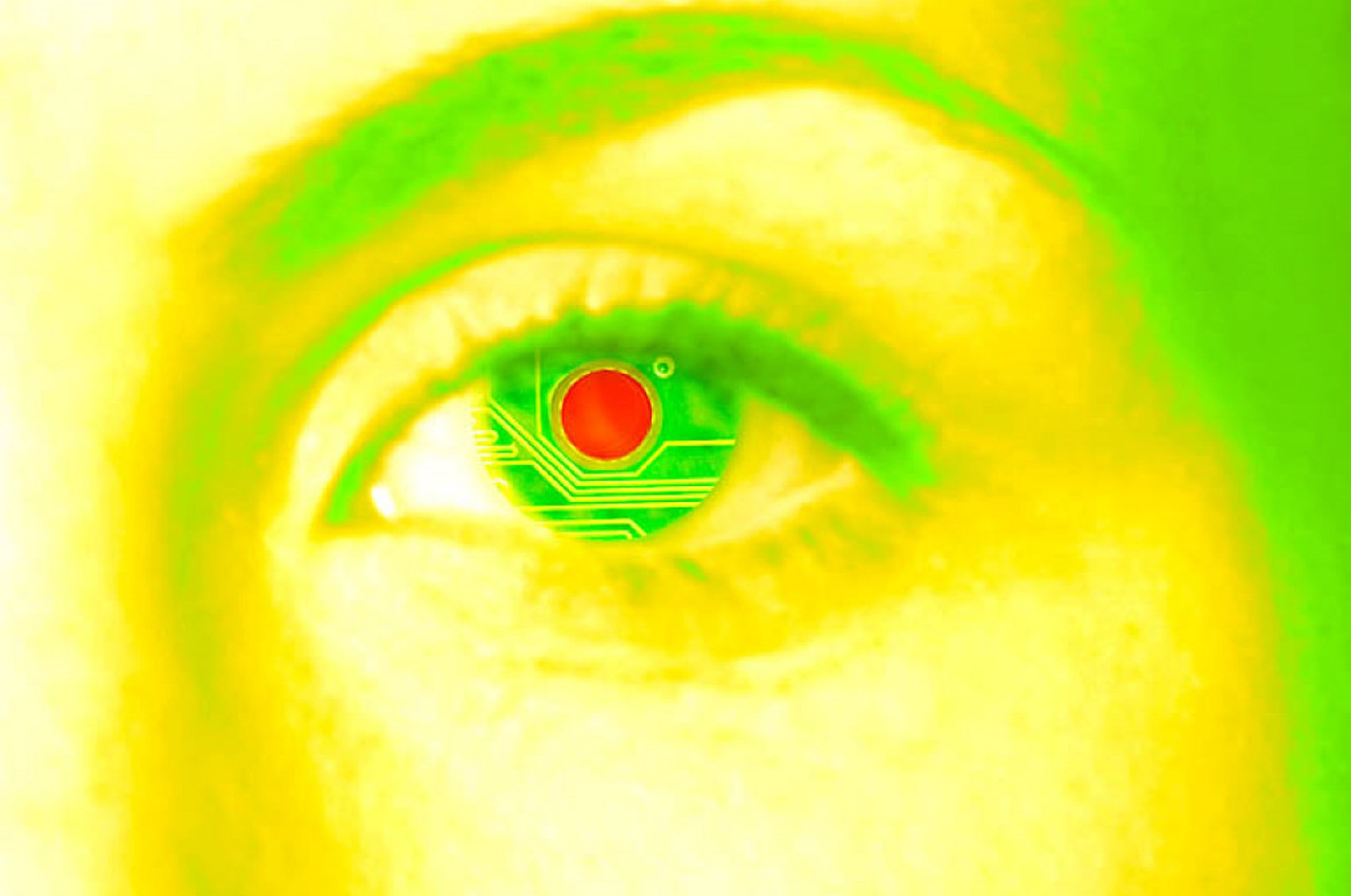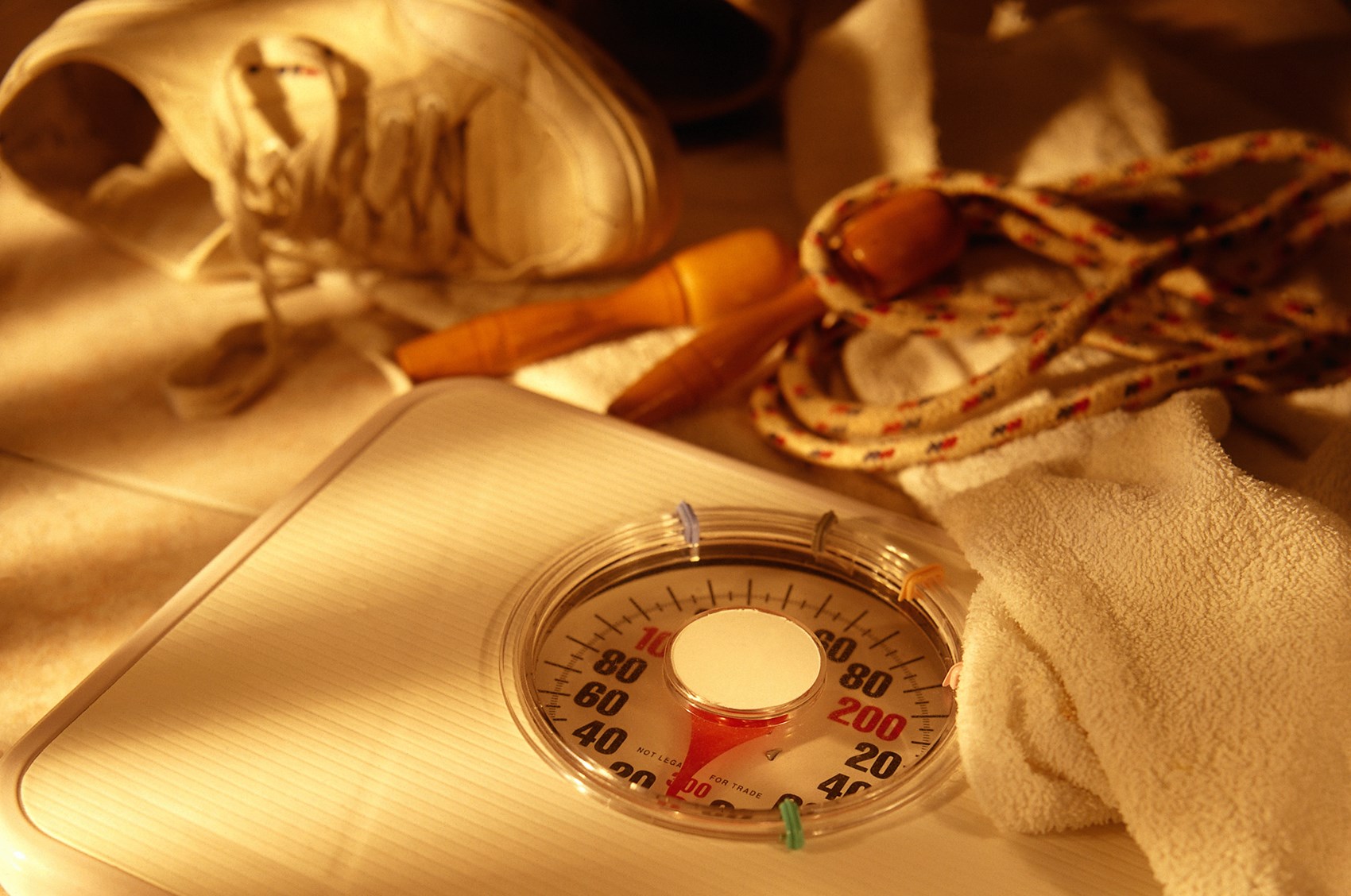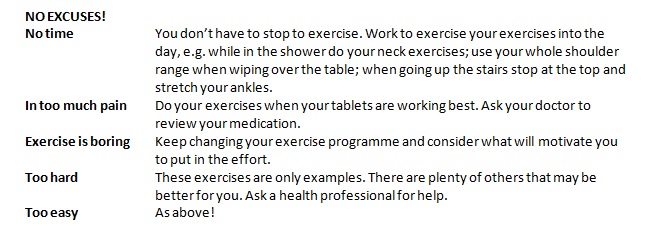
Search
You have no items in your basket

Psoriatic arthritis can cause pain, swelling, stiffness and fatigue which could cause loss of some home/work/recreational function, reduced general fitness and weight gain. An exercise programme suited to your specific needs containing a balance of stretching, strengthening and cardiovascular exercise can help to reduce/optimise these symptoms by increasing physical activity/function/fitness and aid weight loss, In addition physical activity can help reduce stress, improve mood and maintain bone density.
You must try to do some exercise every day. On days when your joints are swollen or painful you should aim to move the affected joints through as great a range as you can without aggravating your pain, regularly throughout the day. Strength and cardiovascular exercise should be performed at least three times a week but may need to be modified if a joint is painful. For example, you may choose to go swimming rather than take a walk if your knees or ankles are painful.
Exercise can lead to some discomfort. Strengthening exercises may sometimes lead to muscle ache, stretching exercises to joint ache, but neither should give rise to acute pain. If exercise leads to swelling or sharp pain, stop and make sure you are doing the exercise correctly. If discomfort lasts longer than a couple of hours you may be working too hard – slow down or reduce your repetitions. It can be difficult to get started with an exercise programme. If you are unsure about any aspect of exercise, ask for advice from your doctor or a physiotherapist.
What is a physiotherapist and how can I get to see one?
Physiotherapists work both in the NHS and privately. They are experts in the examination and treatment of muscles and joints. Some departments may have a physiotherapist with a special interest in rheumatological conditions like psoriatic arthritis and who will work closely with the local consultant rheumatologist. Your GP or consultant can refer you to see a physiotherapist in the NHS or you can self-refer to a private clinic. You can also ask your GP if you can access an external exercise referral scheme.
Osteopaths and chiropractors are also experts in the treatment of musculoskeletal problems. If you choose to see an osteopath or chiropractor, discuss your condition with them before making your appointment, as it is important that they have a clear understanding of it and how it will affect the treatment they can offer you. It’s worth noting that they rarely work in the NHS and so are unlikely to have close links with your rheumatology consultant.
Whichever professional you see, they should be able to help ease the pain of arthritis and improve joint range and function. It is, however, important to recognise that arthritis is a long term condition and experts in the treatment of arthritis will place the focus of treatment on the teaching of self management strategies.
Hydrotherapy is exercise in a warm pool. It is supervised by a physiotherapist, who uses the properties of water to help ease stiff joints and strengthen weak muscles. Unfortunately many pools have been closed and you may not find one locally.
Psoriasis is not usually affected by the water but if you have any concerns you should discuss them with your doctor or physiotherapist. Bring a supply of your usual creams to apply after the treatment. Exercises taught in the hydrotherapy pool can be continued at your local swimming pool.
Everyone has different levels of fitness depending on the lifestyle they lead. Which joints does your arthritis affect? Choose a selection of exercises that will work these joints. Consider what you can currently do (sit for 20 minutes without pain in your back or walk round the park with your dog) and decide on what you would like to be able to do. You can then set yourself goals to work towards, for example you may aim to participate in a local charity walk, learn to swim or be able to walk to the local shop.
Be realistic – set yourself achievable goals
There are two main types of exercise: therapeutic and recreational.
Therapeutic exercises are activities based on your exact needs. They are designed to achieve a certain goal, eg to increase muscle strength. There are two types used for arthritis: range of motion and strengthening.
Range of motion exercises help to maintain joint movement, relieve stiffness and restore flexibility. To increase or maintain range and flexibility you need to take your joints and muscles to their limits. Range of movement exercises should be carried out daily.
Strengthening exercises help maintain or increase muscle strength. To strengthen a muscle you need to apply resistance to the movement. This can be done using your own body weight, weights or resistance bands. Strengthening exercises should be performed on alternate days and not when a joint is hot (feels warm when touched) and painful unless you are supervised by a physiotherapist.
The following exercises are just some examples to get you started. A health professional can design a programme for your specific needs.
Fingers and hands
Repeat ten times.
Repeat five times.
Repeat ten times.
Repeat ten times.
Repeat five times.
Repeat five times.
Neck and back
For the first three exercises sit up straight in a supportive chair, ie one with back support.
Repeat to the other side.
Turn your head to one side until you feel the stretch. Hold for approximately ten seconds. Repeat to the other side.
Repeat five times to each side.
Repeat five times.
Hold for ten seconds, repeat ten times.
Hold for ten seconds, repeat ten times.
Hold for ten seconds, repeat ten times.
Feet and toes
Repeat on the other foot.
Repeat ten times
Repeat ten times.
Repeat ten times.
Hips and knees
Repeat five times with 30-second breaks.
Repeat ten times.
Lie on your back with your knees bent and feet flat on the bed. Lift each knee in turn to meet your stomach, straighten the leg and then lower it to the bed.
Repeat five times.
Jaw
Gently open the mouth to its full width. Stretch a little and hold for five seconds. Then close your mouth completely.
Repeat five times.
Ice packs - you can buy special ice packs from a chemist or they can be made from a packet of frozen peas wrapped in a damp towel. If you use frozen peas remember to label them not to be eaten as they will have defrosted and refrozen if you use the same pack each time and could lead to food poisoning! Ice packs can help reduce the heat and swelling in an inflamed joint. Apply for about ten minutes every two hours. If you have poor circulation, check with your doctor first. Never apply ice directly to the skin.
Rubbing or massaging an area of swelling can help improve the circulation. Ask your doctor about the use of anti-inflammatory gels available at pharmacies.
Splints to help a painful joint can be supplied by a doctor, physiotherapist or occupational therapist. All splints should be prescribed and fitted by a health professional, who will give you advice on when and how long to wear them.
Heat may also be useful to relieve pain and stiffness. The simplest forms are a hot bath or shower, or a hot water bottle or microwave heat packs. These can be useful to relieve morning stiffness. Do not purchase wax baths except on the advice of a doctor or physiotherapist.
A TENS machine gives low voltage, intermittent currents to painful areas and has been shown to help manage pain very effectively. The machines are inexpensive and can be bought or hired. Your doctor or physiotherapist can give you more information.
Look after your health in general and follow the latest recommendations about diet, weight, alcohol, exercise and stopping smoking.
Before undertaking any self-help you may wish to speak to your consultant, GP or healthcare provider to make sure that the activity is appropriate for your needs.


Summary
This article is adapted from the Physiotherapy and exercise: Psoriatic arthritis leaflet.
Download our Physiotherapy and exercise: Psoriatic arthritis leaflet as a pdf